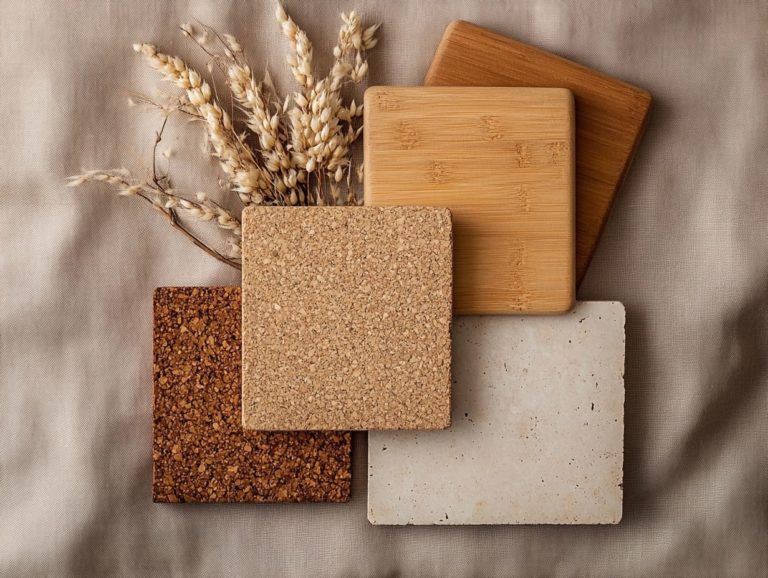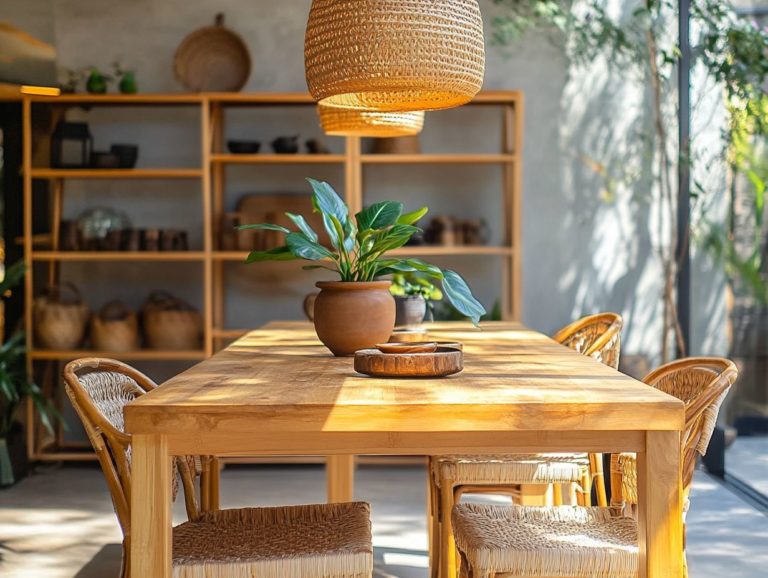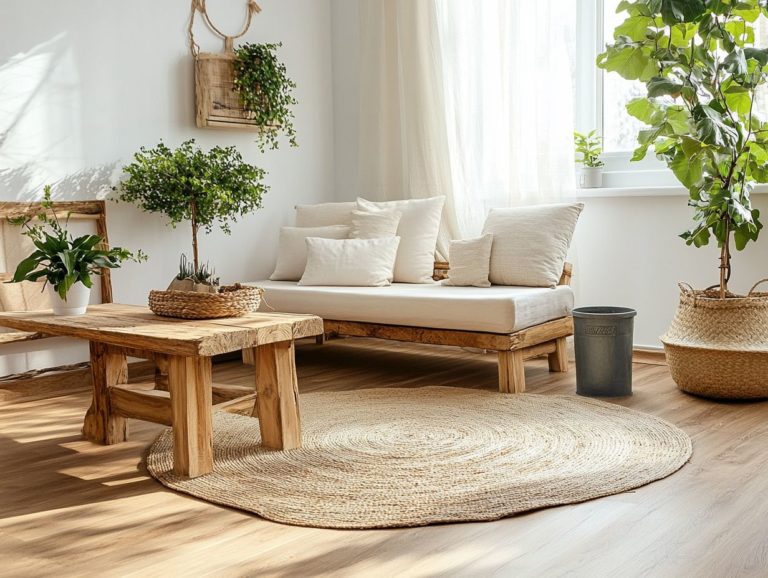How to Research Sustainable Materials for Your Home
In a world that is increasingly attuned to environmental challenges, the choice of materials in your home is more critical than ever.
Traditional materials often carry hidden costs for our planet, driving a shift toward sustainable alternatives.
This article delves into the significance of sustainable materials, guiding you through effective research methods and emphasizing key factors to consider, such as your budget and durability.
From eco-friendly flooring to energy-efficient appliances, you ll discover how to make informed choices that not only elevate your living space but also contribute to a healthier planet.
Contents
- Key Takeaways:
- The Importance of Sustainable Materials
- How to Research Sustainable Materials
- Factors to Consider When Choosing Sustainable Materials
- Examples of Sustainable Materials for Your Home
- Implementing Sustainable Materials in Your Home
- Frequently Asked Questions
- What are sustainable materials for a home?
- Why is it important to research sustainable materials for your home?
- Where can I find information about sustainable materials for my home?
- How can I determine if a material is truly sustainable?
- Are sustainable materials more expensive than traditional materials?
- What sustainable materials are best for my home?
Key Takeaways:

- Understand the impact of traditional materials and why it’s crucial to research sustainable options for your home.
- Consider factors such as environmental impact, budget, and durability when choosing sustainable materials.
- Examples of sustainable materials for your home include eco-friendly flooring, energy-efficient appliances, and recycled or reclaimed materials.
The Importance of Sustainable Materials
The significance of sustainable materials in construction is paramount; they are crucial in reducing carbon emissions, conserving energy, and fostering eco-friendly building practices.
By choosing materials such as recycled steel, bamboo, and natural insulation, you can markedly diminish your environmental footprint while crafting energy-efficient and durable structures.
Embracing sustainable building practices is essential not only for combating climate change but also for securing a healthier planet for generations to come.
Understanding the Impact of Traditional Materials
Traditional construction materials, while commonly employed, pose significant environmental challenges, notably high energy consumption and high carbon emissions.
Materials like concrete and untreated timber often contribute to deforestation and a growing carbon footprint. Take concrete production, for example it s responsible for about 8% of global carbon dioxide emissions, mainly due to the massive energy required for its creation and transportation.
This entire process involves extracting and processing raw materials like limestone, which consumes considerable fossil fuels and generates a significant amount of waste. Harvesting untreated timber can lead to habitat destruction and soil degradation, further intensifying the impacts of climate change.
Research shows that opting for sustainable alternatives could cut building sector emissions by as much as 70%, underscoring the urgent necessity for a shift in construction practices.
How to Research Sustainable Materials
Researching what to look for in sustainable home materials is an essential endeavor for anyone passionate about green building methods. This process empowers you to make impactful choices that significantly reduce environmental impact while ensuring quality and durability.
By diving into renewable resources and prioritizing local sourcing, you can ensure that the materials you choose are not only sustainable but also conveniently accessible.
Finding Eco-Friendly Options
Finding eco-friendly options means recognizing materials that perfectly align with green technology and natural resources, including the best sustainable material brands for homes, both of which are essential for crafting your green home.
Think along the lines of bamboo, cork, and recycled steel materials that deliver environmental benefits.
To dive deeper, consider exploring categories like natural fibers. Options such as hemp and organic cotton stand out for their biodegradability and minimal chemical usage.
Then there are reclaimed materials, which breathe new life into items like reclaimed wood or vintage bricks, thereby reducing waste while preserving unique character.
Don’t overlook the importance of non-toxic finishes, which play a crucial role in enhancing indoor air quality. Low-VOC paints, which have fewer volatile organic compounds, minimize harmful emissions and create a healthier living environment.
By evaluating features like renewability, recyclability, and low environmental impact, you can make informed choices that foster a sustainable lifestyle and elevate your living spaces to new heights.
Start your journey towards a sustainable home today!
Evaluating Environmental Impact

Evaluating the environmental impact of building materials is crucial for ensuring they meet sustainability criteria. You can achieve this through methods like an analysis of a product’s entire life, from production to disposal and a keen understanding of energy efficiency. By engaging in this critical analysis, you empower yourself to make informed choices that effectively reduce your carbon footprint.
When you conduct a life cycle assessment, you’re examining the various stages of a material s life from extraction and production to use and disposal. This thorough examination allows you to pinpoint areas ripe for improvement.
Key metrics to consider include:
- energy consumption
- greenhouse gas emissions
- water usage
Together, these factors create a comprehensive picture of a material’s ecological impact.
Choosing materials with transparent sourcing and eco-certifications not only fosters trust with your clients but also champions responsible production practices. Such actions encourage manufacturers to uphold high environmental standards, ultimately paving the way for a healthier planet and a more sustainable construction industry.
Factors to Consider When Choosing Sustainable Materials
When selecting sustainable materials, consider several key factors to ensure your choices align with eco-friendly practices. For insights on why your home needs more sustainable materials, pay attention to budget constraints and the availability of materials.
Additionally, evaluate long-term durability and maintenance requirements. Each of these elements plays a crucial role in the building process and will ultimately influence the success of your project.
Budget and Availability
Budget and availability are critical factors when selecting sustainable materials, influencing the feasibility of your eco-friendly building projects. It s essential to find materials that are not only cost-effective but also readily available in your local market.
To navigate these constraints successfully, consider exploring local suppliers who specialize in sustainable options; they often offer better prices than larger retailers. Attending regional trade shows or markets can reveal unique, budget-friendly finds that might not be widely advertised.
Collaborating with local designers and builders can also provide valuable insights into unconventional materials that meet both sustainability and budgetary needs. Keep an eye on seasonal sales to understand fluctuating prices and inventory levels. This way, you can ensure that your commitment to eco-conscious practices doesn t stretch your budget too thin.
Long-Term Durability and Maintenance
Long-term durability and maintenance are critical when selecting sustainable materials, as they directly influence the lifespan of a building and its overall energy efficiency. By opting for materials that demand minimal upkeep, you can achieve significant cost savings and reduce your environmental impact over time.
Evaluating the durability of these materials gives you the power to make informed decisions that enhance the performance of your structures for the long haul. Consider options like recycled metals, bamboo, and high-performance insulation each of which not only minimizes waste but also markedly improves thermal management, or the way materials help keep homes warm in winter and cool in summer.
Incorporating maintenance practices, such as regular inspections and timely repairs, can effectively extend the lifespan of these materials. By prioritizing these essential aspects, you can contribute to a more sustainable future while ensuring that your investments deliver enduring returns in efficiency and comfort.
Examples of Sustainable Materials for Your Home
Explore the incredible range of sustainable materials available to transform your home. From eco-friendly insulation options to recycled materials that play a pivotal role in waste reduction, learning how to select sustainable materials for DIY projects can help you make the best choices, as the options are abundant.
These materials not only elevate energy efficiency but also align perfectly with a green lifestyle, embodying the very principles of sustainable construction.
Start your sustainable journey today by choosing eco-friendly materials for your next project!
Eco-Friendly Flooring Options

Eco-friendly flooring options present a remarkable opportunity for you to integrate sustainable materials into your home. Choices like bamboo, cork, and recycled rubber not only enhance your space’s aesthetic appeal.
They also bring significant environmental benefits. These materials are designed to be durable and contribute to improved indoor air quality, creating a healthier living environment.
By opting for such flooring solutions, you can drastically reduce your carbon footprint while enjoying the attractive designs these materials offer. Let s explore the benefits and characteristics of each option.
- Bamboo, for instance, is rapidly renewable and impressively strong, making it ideal for high-traffic areas.
- Cork provides natural insulative properties, enhancing comfort and offering a unique texture underfoot.
- Recycled rubber is particularly resilient, making it perfect for spaces where moisture could be a concern.
Regarding installation, most eco-friendly options require standard tools, though some may need specific glue or padding. Maintenance varies: bamboo typically needs resealing every few years, while cork benefits from an occasional waxing to keep its luster intact.
Energy-Efficient Appliances and Fixtures
Incorporating energy-efficient appliances and fixtures is essential for sustainable home design. These products significantly reduce energy consumption and lower your overall energy costs.
Opting for appliances that utilize renewable energy sources further enhances their eco-friendly credentials. For instance, when you choose ENERGY STAR-rated refrigerators and washing machines, you not only aid the environment but also enjoy lower utility bills over time.
By investing in LED lighting, which consumes up to 75% less energy than traditional incandescent bulbs, you can illuminate your home while minimizing your carbon footprint. Don t wait switching to these appliances today can lead to significant savings tomorrow!
These energy-efficient choices contribute to long-term savings and play a crucial role in combating climate change. Making informed decisions about your appliances paves the way for a more sustainable lifestyle and a healthier planet for generations to come.
Recycled and Reclaimed Materials
Recycled and reclaimed materials present an exceptional opportunity for you as a homeowner to embrace sustainable building practices. By opting for these materials, you significantly reduce waste and foster a sense of environmental stewardship.
Think about how exciting it is to incorporate elements like reclaimed wood and recycled steel into your home each piece not only adds unique character but also champions eco-friendliness.
These choices do more than just divert materials from landfills; they also diminish the demand for new resources, conserving energy and reducing your carbon footprint. You can source these materials from local salvage yards, demolition sites, or specialized suppliers, often unearthing one-of-a-kind treasures that carry their own stories.
Look at projects like the Bullitt Center in Seattle or the High Line in New York City. They show how sustainable materials can create beautiful spaces, proving that practicality and sustainability can coexist in harmony.
By selecting recycled and reclaimed options, you elevate both the aesthetics of your space and the ecological impact of your building choices.
Implementing Sustainable Materials in Your Home
Implementing sustainable materials in your home is a nuanced endeavor that demands meticulous planning and thoughtful consideration. Each choice you make should harmonize with eco-friendly practices while enhancing energy efficiency.
From the initial stages of construction to the final touches, integrating sustainable options can transform your living space into a greener, healthier haven.
Start your journey to a sustainable home today every small choice counts!
Tips for Successful Integration
To ensure you successfully integrate sustainable materials into your home, consider practical tips that enhance eco-friendly building practices while maintaining aesthetic appeal and functionality. Understanding the impact of sustainable materials on home design and collaborating with knowledgeable professionals can truly make a significant difference.
Engaging with builders who prioritize sustainable practices empowers you to make better decisions regarding materials and methods. When selecting products, it’s essential to find certifications like Energy Star or LEED, as they can guide your choices effectively.
Fostering open communication with suppliers enables you to explore creative solutions tailored specifically to your project’s needs. Regular check-ins to assess progress will help keep sustainability at the forefront throughout the construction process.
Focus on sustainability and start making your home more sustainable today! You can contribute to a healthier environment and potentially save on future energy costs.
Frequently Asked Questions

What are sustainable materials for a home?
Sustainable materials are eco-friendly and have less impact on resources. They are often made from renewable or recycled materials and are energy-efficient.
Why is it important to research sustainable materials for your home?
Researching local sustainable materials for your home lets you make informed choices that benefit the environment, save money in the long run, and create a healthier living space for your family.
Where can I find information about sustainable materials for my home?
Many resources are available to research sustainable materials, including online databases, environmental organizations, and government websites. You can also consult sustainable building professionals for expert advice.
How can I determine if a material is truly sustainable?
Look for certifications and labels such as Energy Star, Cradle to Cradle, or Forest Stewardship Council (FSC) to ensure the material meets specific environmental standards. You can also check the material’s production process and its impact on the environment.
Are sustainable materials more expensive than traditional materials?
In some cases, sustainable materials may cost more upfront. However, they often have a longer lifespan and can save you money in the long run through energy efficiency and low maintenance costs. The environmental benefits of using sustainable materials typically outweigh the initial cost.
What sustainable materials are best for my home?
The best sustainable materials for your home depend on factors like your budget, location, and specific needs. Some popular options include bamboo, reclaimed wood, recycled glass, and energy-efficient appliances. Understanding why sustainable materials are essential for green homes is also crucial. It’s important to do thorough research and consult with experts to determine the best options for your home.






